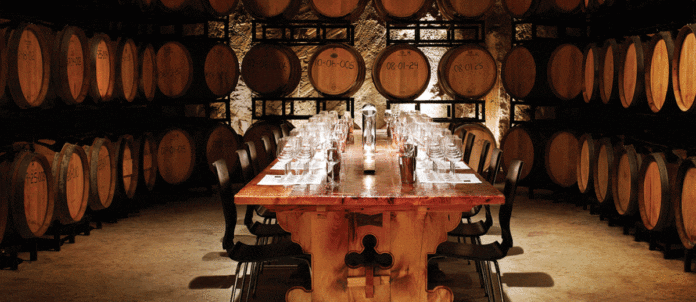Volume 47, Number 9
[dropcap size=big]O[/dropcap]ntario wines were not taken seriously for years, but icewine helped change that in 1991, when Inniskillin’s 1989 Vidal Icewine won the Grand Prix d’Honneur at Vinexpo in Bordeaux, France.
Today, Ontario is one of the world’s leading producers of icewine, with approximately 60 wineries bottling nearly 900,000 litres of the golden elixir annually, according to Vineland, Ont.-based Wine Country Ontario, which promotes the province’s wine-growing regions. Ontario’s hot summers and cold and sharp winters ensure an icewine harvest most years, since grapes must be handpicked in the middle of the night when they are frozen solid and temperatures are -8°C.
This year, Canada won its first International Trophy at the 2014 Decanter World Wine Awards. Inniskillin’s 2012 Vidal Icewine took top prize in its category, but many Ontario wines were honoured with the prestigious award. “People still have this vision in their minds that in Ontario we only produce icewine,” says James Treadwell, sommelier and owner at Treadwell Farm-to-Table Cuisine in Niagara-on-the-Lake, Ont. “It’s very exciting what’s happening now in terms of Chardonnay. There are exceptionally fine Chardonnays being produced at different price points.” Indeed, Flat Rock Cellars’ 2012 Rusty Shed Chardonnay was honoured with a gold award by Decanter magazine. When it comes to red, Hidden Bench’s 2011 Locust Lane Pinot Noir was among the Canadian silver winners.
Despite its 200-year history, Ontario is a relative newcomer to the world of winemaking. Ontario’s first winery, Vin Villa Winery, was established in 1866 on Pelee Island on Lake Erie. And, Inniskillin was granted the first winery licence since 1916 in 1974, when the modern era of winemaking in Ontario began. In 1988, Ontario wine producers created the Vintners Quality Alliance (VQA) to identify geographic appellations and introduce standards for production, including a guarantee that VQA wines are made from 100-per-cent Ontario-grown grapes.
In 2004, the VQA Award of Excellence was created by Wine Country Ontario to recognize licensees who embrace Ontario VQA wines and have high professional standards in wine service. “It’s about our industry recognizing excellence and bringing attention to those businesses that help us share our local story and have confidence in how great Ontario VQA wines are,” says Magdalena Kaiser, director of Public Relations, Marketing and Tourism for Wine Country Ontario.
This year the initiative was relaunched as the We Love Wine Country Ontario restaurant recognition program. The goal is to promote VQA wines and to help customers find their favourite VQA wines outside of wine country. To qualify, restaurants must offer Ontario VQA wine by the glass and have a wine list comprising 25 per cent or 25 varieties of Ontario VQA wines. Treadwell is a staunch supporter of the program. “Everybody wins. It’s about building an industry that’s been around for a [few] years, but we’ve only scratched the surface in terms of its potential. We’re proud to work with wineries in terms of building their brand but also building ours, too.”
Treadwell’s wine list comprises up to 80 per cent local selections and complements the restaurant’s food philosophy, which emphasizes the best artisan producers from Niagara and surrounding regions. “There are some amazing wineries, which 90 per cent of the public don’t even know about,” he notes, pointing to small-scale producers who may only bottle 150 cases of wine and can’t get into retail. “That’s the most exciting thing, because not only are you giving [customers] the opportunity to try something different, but you’re also supporting very small producers who are passionate and who are doing it just for the love of making wine.”
Kathleen Moore, head sommelier and beverage manager at Langdon Hall Country House Hotel & Spa in Cambridge, Ont., has also been a longtime supporter of Ontario wine. “We are making some outstanding wine,” she says. “People [have preconceived notions that] we can’t make red wine in Ontario or that we focus on Riesling for grape production, and that Riesling is always sweet. But when I put a dry Riesling in front of them, they’re pleasantly surprised.”
Kaiser says Ontario now boasts approximately 150 VQA wineries. The cool climate creates grapes that are aromatic and higher in acidity, which complement food. “You look at acidity like a wedge of lemon or salt; it brings out the flavours of a dish really well,” Farm-to-Table’s Treadwell explains.
Moore agrees, adding that the relatively lower alcohol content of Ontario wine allows the food to shine, making the whole dining experience more pleasurable. “If you have a higher alcohol wine, it feels very weighty and heavy on the palate,” she says. “It masks the food.”
But, in addition to the natural acidity that makes Ontario wine a great accompaniment to food, it’s also versatile, aromatic and ages well. “Some of the wines are too young to be drunk when released; they need a few years to come together,” advises Moore. “I’m still serving 2002 Peninsula Ridge Cabernet [Sauvignon] and Merlot Reserve, and they’re beautiful now. They’re drinking very well.”
Though Langdon Hall offers more than 1,000 international wines, the resort attracts visitors who want to see what’s being made in its backyard. So Moore showcases more than 250 Ontario wines. “Restaurants should really get involved with this whole local movement,” Moore says. “It’s great for marketing; it’s great for the environment. We should showcase what great products are coming out of our province and help support our industry.”


















